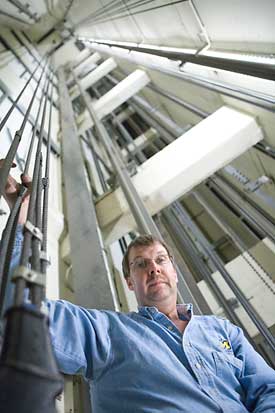As one of the 11 licensed mechanics at the Elevator Shop, Frank Seaburg is skilled in maintaining and servicing any of the 500-plus elevators on campus.

Seaburg, who has worked in the Elevator Shop since 1996, loves the satisfaction he gets from fixing a building’s elevator. “The people within the buildings are all super, and while I may not remember all of their names, the experience of leaving the building, knowing I fixed their elevator and made their day, is a great feeling.”
He says the busiest time of the year for elevator mechanics is student move-in and move-out, when elevators are subject to “a lot of abuse.” During these periods, he has spotted people trying to pry elevator doors open by sticking an edge of their box or cart between the doors.
“Usually the doors do open, due to an infrared light ray on the elevator doors,” he says. “But if the elevator’s doors are hit, they can come off their track and shut down the elevator. Elevators will also shut down when dirt, pushpins and screws get stuck in their tracks. That is where the Elevator Shop comes in handy for the repair.”
Every now and then while making his rounds, Seaburg finds the occasional M-Card, iPod, or cell phone, usually in bits and pieces. His advice is to “add insurance to your cell phone in case it falls down an elevator shaft. You can get it out, but there’s no guarantee it’ll work.” Often, people who accidentally drop those items down the hoistway call elevator mechanics to retrieve them, he says.
Depending on the day, elevator mechanics may visit anywhere from one to a dozen elevators in a single shift, although the days of servicing more than a couple during one day are “few and far between,” he says.
The building with the most elevator stops is Wolverine Tower with 12. The elevator with the greatest weight capacity of is the Phoenix Memorial Laboratory freight elevator at 30,000 pounds.
While some may haul themselves up and down flights of stairs to avoid elevators, the likelihood of anything unusual happening on an elevator on campus is slim to none.
That message really hits home when one considers the fact that one cable on a traction elevator can hold the weight of a fully loaded elevator plus 25 percent—and there are at least four cables on traction elevators. Beyond that, mechanics at the Elevator Shop are available in 15 minutes or less in case a problem occurs.
Thirty of the elevators on campus are more than 50 years old. The single operating button elevator in the Observatory Lodge, one that Seaburg calls “seriously antique,” is slated for replacement this year. Old age, however, doesn’t necessarily signify that an elevator will break down more often. Older elevators on campus run on relay logic systems rather than microprocessors, which Seaburg likens to changes in computer technology.
“The technologies change just as rapidly. With the microprocessors, everything is great at first, but I think over time, you’re going to find that they need major overhauls more quickly than the old relay logic elevators did. I don’t know of many companies out there who build things to last indefinitely.”
When he is not at work, Seaburg enjoys spending time on the lake and traveling with his wife and two children.

